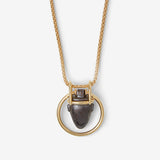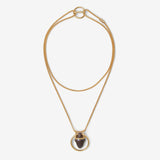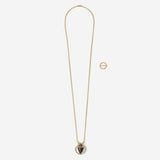I HEART YOU NECKLACE IN HEMATITE
ORIGINAL ANTIQUITY
ANCIENT · EGYPT
We attend all our customers personally. Please leave us your contact details for information and sales.
We attend all our customers personally. Please leave us your contact details for information and sales.
DESCRIPTION
ORIGINAL HEMATITE HEART AMULET (1570-1069 BC) · Egyptian amulets came in a wide variety of stones and colours. Two golden circles for pendant and clasp build a contemporary link with the original use of this heart amulet in Egyptian mythology: the circle as a symbol for continuity, as a symbol for life.
Designed for any occasion, our necklace can be worn full opera length (80cm/32”) or as a double chain choker (40cm/16”).
-
18k yellow gold
-
Pendant size 3.4x2.8cm/1.3x1.1”
-
Amulet size 2.4x2.1cm/0.94x0.83"
-
Clasp size 1.9cm/0.75” diameter
-
Chain thickness 2.3mm

EGYPTIAN HEART AMULET (1570-1069 BC)
The ancient Egyptians considered the heart as the source of human wisdom, emotions and memory. The weighing of the heart played a key role in the judgement ceremony for passing to the afterlife.
Heart amulets were used to protect the owner’s heart, and to influence a positive outcome in the weighing of the heart ceremony.
We know that heart amulets were already in use as early as the 11th Dynasty among the circle of Theban royalty. The first known depiction of the heart amulet is only found in the beginning of the 18th Dynasty. During the late period, its use became widespread and extended to all layers of Egyptian society.
Egyptian heart amulets come in a wide range of colours and materials: jasper, carnelian, agate, lapis lazuli, hematite and even glass.



-
M. Yalom, The amorous heart: an unconventional history of love
-
V. Evans, The emoji code: the linguistics behind smiley faces and scaredy cats
-
R. Sousa, The meaning of the heart amulets in Egyptian art
-
R. Sousa, The heart of wisdom: studies on the heart amulet in ancient Egypt
Acquired at an antiquities dealer in London, legally exported under the British and European legislation for export of cultural goods. Authenticity has been certified by C.M., member of the British Treasure Valuation Committee and Deputy Chairman of ADA (Antiquities Dealers Association).
This specific amulet comes from a private English collection, formerly part of lot 322 of the second part of The W. H. Forman auction, Sotheby's, July 2-5, 1900.
A LOVE STORY OF GLYPHS AND EMOJI
Ancient Egypt was an epoch of many gods, of many beliefs, and of many, many symbols. The djed amulet, the double plumes, the wedjat eye, the menat amulet: they came, they were once wildly popular, and they have all disappeared into oblivion. All except for one: since its first symbolic use by the Egyptians, the heart started its unstoppable rise to becoming the largest icon in history. This is a tribute to the oldest symbol for the deepest emotions. It is a story of life, it is a story of love. It all began 4000 years ago at the shores of the river Nile...

In 1976 Milton Glaser drew a “I ❤️ NY“ sketch that became an icon and was eventually included in the MoMA collection. At that precise moment, in the back of a taxi, the heart symbol became a verb, the first ever lingual expression beyond the alphabet.
Some 20 years later, just before the turn of the century, Japanese artist Shigetaka Kurita designed a list of 176 emoji, now also part of the permanent collection of the MoMA. A new human expression was born, and with 5 icons, the heart was at the centre of it. After more than 2000 years, glyphs are back. Today, 4 of the 10 most frequently used emoji include a red heart.
The name for the heart hieroglyph was “ib”. For the ancient Egyptians, the heart was the source of wisdom, emotions and the soul itself. Given their limited anatomical knowledge, a logical conclusion. A constant, powerful beat, that accelerates with excitement and ceases with death. The heart was the only organ left in place during mummification, and played a central role in the passing to the afterlife. Heart amulets were the first symbolic representations, iconic for ancient Egypt.
Later, Greek poets and philosophers added a “love” dimension to the heart, picked up and popularized by the Romans. From Venus to Valentine, love became quickly synonymous with an endless stream of heart shaped cards and jewels.
Today, we don’t send brain icons, we don’t send dollar signs. We send hearts. Symbol for life, symbol for love, this heart amulet circles us back from the age of emoji to the age of glyphs.
If it is too big for words, say it with a heart.








